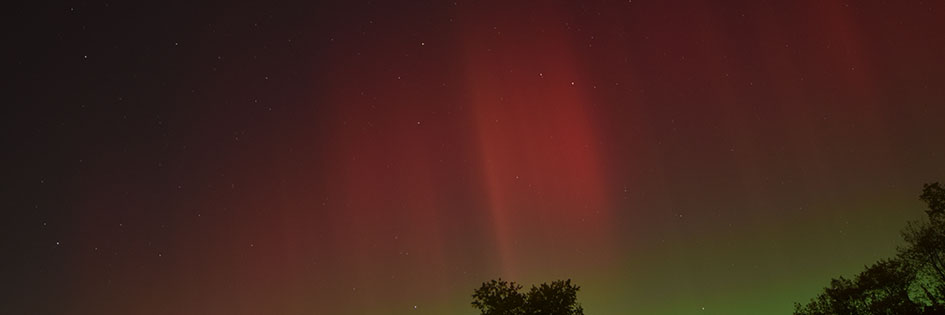Aurora!
In early May, there was an intense solar flare on the center of the sun’s visible disk. It was the most intense solar flare in two decades. Being at the center of the sun’s disk meant that the burst of charged particles from the flare was directed toward the earth. When particles from solar flares reach the earth about a day later, they can interact with the earth’s magnetic field to produce an aurora borealis (aurora australis in the Southern Hemisphere), or northern lights. Sure enough, that evening I spotted some green and red arcs from my front yard, albeit through breaks in the clouds. I excitedly alerted my neighbors who happened to be outside, as well as my wife and some houseguests we had. But by the time I set up my camera, the clouds thickened, and soon, the entire sky was socked in for the rest of the night. Meanwhile, much of the United States was treated to the best auroral display in decades.
We are in the solar maximum of the 11-year sunspot cycle, so I had some confidence that I might yet see an aurora this year. I didn’t have to wait long. On Thursday, October 10, there was a solar flare, and alerts went out for possible auroral activity the next night or two. As it so happened, I had planned to take a few friends to the Johnson Observatory on the grounds of the Creation Museum on Thursday evening. I told my guests of the possibility of seeing an aurora, but as the sky darkened, we didn’t see anything unusual in the sky. The moon was at first quarter, so everyone was delighted to see the moon up close through one of our telescopes. We used two other telescopes to look at the globular cluster M13, the Ring Nebula (M57), and the Andromeda Galaxy (M31). Saturn is my favorite thing to look at through the telescopes, and I never get tired of seeing it. And Saturn did not disappoint. Saturn usually is the showstopper, but on Thursday evening, it was eclipsed by something better.
A little past 9:30 p.m., my guests were getting ready to leave when I thought the sky to the north looked a little brighter than usual. I thought, “Could that be an aurora?” With proper settings, the camera can capture things too faint for the eye to see, so I quickly set up one of my cameras on a tripod and began taking photographs. Jim Bonser, an Iowa pastor and amateur astronomer was with us, and he thought the same thing, so he began taking photographs with his cell phone.
We saw red and green light in the sky for about a half hour, and then it was over.
About the same time, our first photographs revealed that an aurora was underway. Others began to take photos with their cell phones, and we kept looking at our photos while keeping an eye on the sky. After a few minutes, I drew attention to a red pillar of light that I could faintly see. It rapidly brightened, and soon other pillars appeared, and then they began to move. I eventually began taking photos to make a time-lapse video of the motion of the auroral arcs. We saw red and green light in the sky for about a half hour, and then it was over.
I’m sharing here one of my better photographs, as well as a time-lapse video that I made from 331 two-second photos I took between 10:04 p.m. and 10:31 p.m. The latter shows the rapid changes in the aurora. An aurora is an amazing display of God’s glory (Psalm 19:1). We can probably expect a few more nights like this over the next year, so stay tuned. I’ll share any new photos that I take and videos that I make.
Note: As I mentioned, Jim Bonser, who attended the Answers for Pastors and Leaders conference at the Answers Center with his wife, was at the observatory. Jim is an accomplished astrophotographer, and he supplied many of the photographs that made my coffee-table book, The Heavens: A Different View, so beautiful.

Answers in Genesis is an apologetics ministry, dedicated to helping Christians defend their faith and proclaim the good news of Jesus Christ.
- Customer Service 800.778.3390
- Available Monday–Friday | 9 AM–5 PM ET
- © 2026 Answers in Genesis

